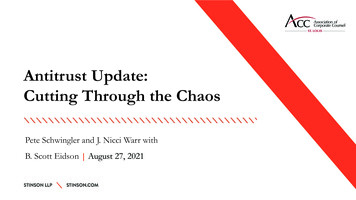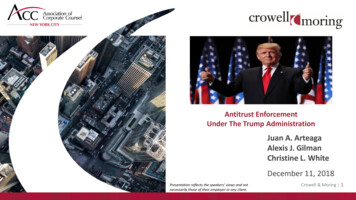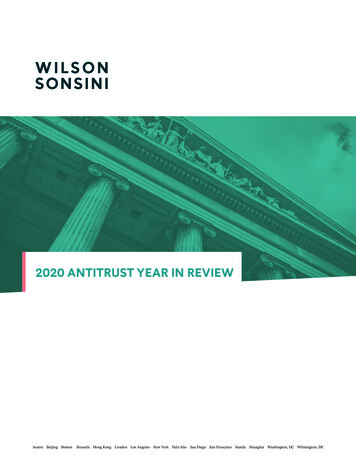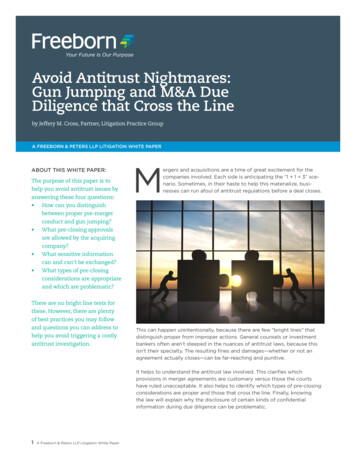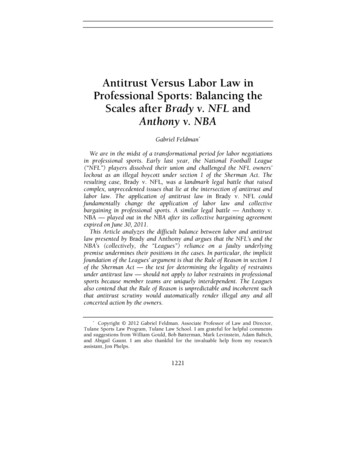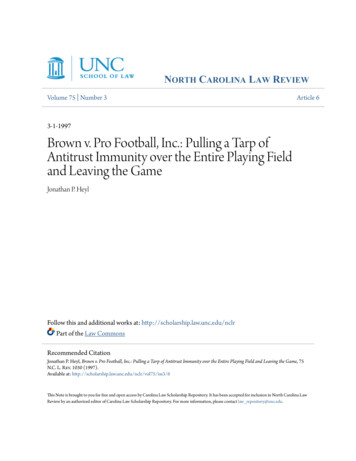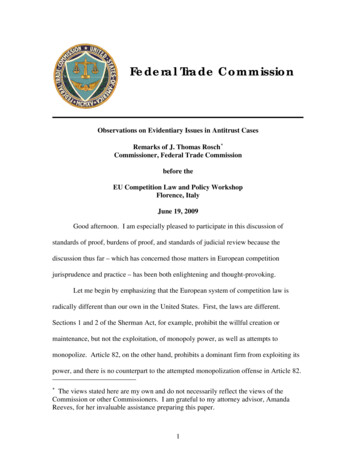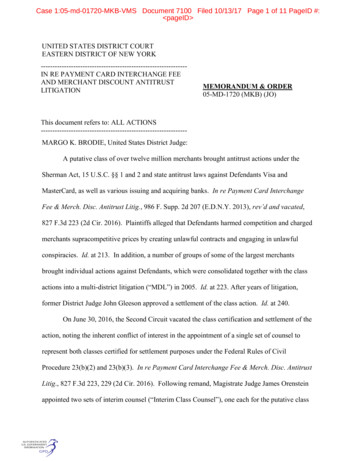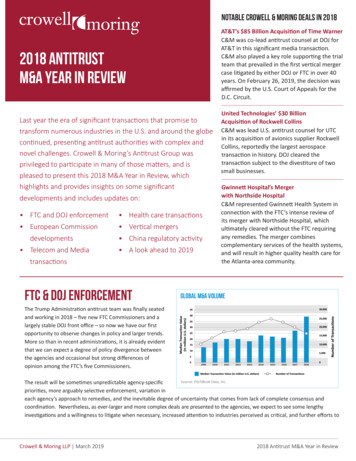
Transcription
Notable Crowell & Moring Deals in 2018AT&T’s 85 Billion Acquisition of Time WarnerC&M was co-lead antitrust counsel at DOJ forAT&T in this significant media transaction.C&M also played a key role supporting the trialteam that prevailed in the first vertical mergercase litigated by either DOJ or FTC in over 40years. On February 26, 2019, the decision wasaffirmed by the U.S. Court of Appeals for theD.C. Circuit.2018 AntitrustM&A YEAR IN REVIEWLast year the era of significant transactions that promise totransform numerous industries in the U.S. and around the globecontinued, presenting antitrust authorities with complex andnovel challenges. Crowell & Moring’s Antitrust Group wasprivileged to participate in many of those matters, and ispleased to present this 2018 M&A Year in Review, whichhighlights and provides insights on some significantdevelopments and includes updates on: FTC and DOJ enforcement Health care transactions European Commission Vertical mergersdevelopments Telecom and Media China regulatory activity A look ahead to 2019transactionsFTC & DOJ ENFORCEMENTThe Trump Administration antitrust team was finally seatedand working in 2018 – five new FTC Commissioners and alargely stable DOJ front office – so now we have our firstopportunity to observe changes in policy and larger trends.More so than in recent administrations, it is already evidentthat we can expect a degree of policy divergence betweenthe agencies and occasional but strong differences ofopinion among the FTC’s five Commissioners.United Technologies’ 30 BillionAcquisition of Rockwell CollinsC&M was lead U.S. antitrust counsel for UTCin its acquisition of avionics supplier RockwellCollins, reportedly the largest aerospacetransaction in history. DOJ cleared thetransaction subject to the divestiture of twosmall businesses.Gwinnett Hospital’s Mergerwith Northside HospitalC&M represented Gwinnett Health System inconnection with the FTC’s intense review ofits merger with Northside Hospital, whichultimately cleared without the FTC requiringany remedies. The merger combinescomplementary services of the health systems,and will result in higher quality health care forthe Atlanta-area community.global M&a ce: PitchBook Data, Inc.The result will be sometimes unpredictable agency-specificpriorities, more arguably selective enforcement, variation ineach agency’s approach to remedies, and the inevitable degree of uncertainty that comes from lack of complete consensus andcoordination. Nevertheless, as ever-larger and more complex deals are presented to the agencies, we expect to see some lengthyinvestigations and a willingness to litigate when necessary, increased attention to industries perceived as critical, and further efforts toCrowell & Moring LLP March 20192018 Antitrust M&A Year in Review
More so than in recent administrations,it is already evident that we can expecta degree of policy divergence betweenthe agencies and occasional but strongdifferences of opinion among the FTC’sfive Commissioners. The result will besometimes unpredictable agencyspecific priorities, more arguablyselective enforcement, variation in eachagency’s approach to remedies, and theinevitable degree of uncertainty thatcomes from lack of complete consensusand coordination.streamline the merger review process. We also expect a robust levelof agency participation in domestic and international policy fora toadvance the agencies’ respective agendas, but with the potential foradvocacy of some divergent positions.A few highlights bear special mention. The DOJ’s sole litigated casewas its failed challenge to AT&T’s acquisition of Time Warner—thefirst effort by either U.S. agency to litigate a vertical merger tojudgment in over 40 years. It also undertook deep-dive investigationsof the tie ups between pharmacy benefit managers and healthinsurance companies that included vertical dimensions, but it did notseek to block any other merger. For its part, the FTC brought threehorizontal merger challenges, winning one and seeing the othersabandoned before judicial resolution. FTC staff also tried anadministrative case (decision pending), and defended a favorabledistrict court decision before the Eighth Circuit. The FTC also launchedan ambitious series of hearings entitled Competition and ConsumerProtection in the 21st Century, which will cover a variety of mergerenforcement and other issues. These hearings may lead to new enforcement priorities and policy pronouncements.Both agencies negotiated relief in many other cases without going to court, as is typical, and we also saw a continued commitmentto focus enforcement resources in the telecom/internet/tech space, agriculture, and health care industries. The DOJ also announcedchanges to its model timing agreement and merger review process, intended to allow most merger investigations to be completedwithin six months, and the FTC published a model timing agreement. It does not appear, however, that the DOJ and FTC have beenclosely coordinating these efforts.Merger remedy policy is an area we will be watching and that may divide the agencies, especially with regard to the relativedesirability of structural and behavioral remedies. Assistant Attorney General Delrahim has forcefully expressed his preference forstructural remedies over “regulatory,” behavioral remedies. In May 2018, DOJ announced the Bayer/Monsanto consent order, toutedby the DOJ as the “largest negotiated merger divestiture ever.” In contrast, FTC Chairman Simons has stated a concern over thefailure rate of partial divestitures and Commissioner Chopra has criticized the mixed track record of divesting assets to private equitypurchasers. Differences of opinion may prove to be case-specific, however. In an unusual joint venture matter, the FTC unanimouslyaccepted an elaborate behavioral remedy that included the appointment of a private monitor. But in early 2019, the Commissionerssplit 3-2 in resolving the Staples/Essendant merger that included vertical issues, with the majority supporting a behavioral remedydecree including a monitor, and Commissioners Chopra and Slaughter dissenting, questioning the likely effectiveness of the remedy.EU: 2018 BRINGS RECORD-BREAKING NUMBER OF MERGERFILINGS, BUT NO INCREASE IN INTERVENTIONWith a total of 414 notified transactions, 2018 saw the highest number of notifications to the European Commission in the history ofthe EU merger control regime, surpassing the previous record of 402 in 2007. In the last five years, filings have gone up by almost50%, although the Commission was able to process 75% of filings through a simplified procedure introduced in 2014.No transactions were blocked in 2018, although two were abandoned in Phase II (and, in early 2019, the Commission blocked twotransactions that it had started to examine in 2018, Siemens/Alstom and Wieland/Aurubis Rolled Products/Schwermetall). With 23transactions approved with remedies (17 in Phase I and 6 in Phase II), the Commission’s intervention rate of 6% (27% of nonsimplified notifications) was in line with previous years. Four transactions were cleared unconditionally in Phase II, showing that theopening of a Phase II investigation does not necessarily mean that the parties have to offer commitments to obtain clearance.Crowell & Moring LLP March 2019
We observe a trend towards increasingly longer “prenotification” talks with the European Commission, indicating that mergingcompanies are holding off on filing in hopes of resolving issues before the clock starts on Phase I. This trend runs counter to theoriginal intent of the EU merger regulation, which aims to give companies legal certainty by setting a strict timetable.In terms of substance, a few cases are noteworthy. Together with the 2017 Dow/DuPont decision, the 2018 decision in Bayer/Monsanto shows an increased focus on the effects of mergers on innovation. In Apple/Shazam, cleared unconditionally in Phase II,the Commission investigated a novel theory of harm based on the use of data, namely the concern that Shazam controlled a uniquedataset of consumers’ music preferences, which might have allowed Apple to tip the market for digital music streaming services in itsfavor. While the investigation did not result in a challenge, the Commission’s analysis may provide a blueprint for the assessment offuture cases involving unique datasets. Daimler/BMW car sharing JV stands out due to the novelty of the remedies: API (applicationprogramming interface) access was granted to third-party aggregator platforms for mobility solutions and access to Daimler’sintegrator app was granted to other car sharing providers. The Commission’s unconditional phase II clearance of T-MobileNetherlands/Tele 2 Netherlands undermines the perception that under Commissioner Vestager the Commission is no longerprepared to allow four-to-three mergers in mobile telephony markets. On 6 February 2019, it was announced that the Commissionhad vetoed the merger between the two largest European manufacturers of trains, Siemens and Alstom, resisting pressure from theFrench and German governments to help create a “European champion” able to take on State-backed foreign rivals, such as China’sCRRC, the world’s biggest train maker.After hitting Facebook with a record fine of 110m in 2017 for providing misleading information in relation to its acquisition ofWhatsApp, the Commission continued to get tough on procedural infringements in 2018 by imposing a 125m fine on Altice for “gunjumping” in its acquisition of PT Portugal. Several other investigations into procedural infringements are ongoing.EU Merger ControlEC Decisions 2013 – 14Withdrawals (Phase II)Withdrawals (Phase I)201320142015201620172018TELECOM AND MEDIAIn an era marked by an explosion of new video content and a rapid evolution in the way viewers are consuming it, several companiespursued major transactions in 2018 to better position themselves to compete in a world where tech giants like Netflix, Google, Facebook,and Amazon are making enormous investments based on new business models. As consumers increasingly abandon traditional lineartelevision in favor of consuming more content online, and on mobile devices in particular, industry participants are undertaking majortransactions to position themselves for the future.In June 2018, AT&T and Time Warner completed their 85 billion transaction combining AT&T’s distribution platforms with Time Warner’sportfolio of content. The companies explained that the combination would enable innovative content delivery and advertising platforms,which would help the combined firm compete with online giants that both own and distribute content like Netflix, Amazon, and Hulu. DOJdeclined to clear the deal with behavioral remedies despite having done so in prior similar deals like Comcast/NBCUniversal and insteadsued to block a vertical merger for the first time in over 40 years. DOJ argued that the combined firm would have increased bargainingleverage allowing it to charge rival distributors more for Time Warner’s popular content, which in turn would lead to higher prices forconsumers.2018 Antitrust M&A Year in Review
After a three week bench trial, Judge Richard J. Leon denied the government’s request for an injunction and approved the merger withoutconditions. The decision noted the recent changes to the media landscape, including the “rise and innovation of over-the-top, verticallyintegrated video content services,” “declining [traditional pay TV] subscriptions,” and the “shift toward targeted, digital advertising.” TheCourt acknowledged that vertical mergers produce efficiencies, including the 350 million per year in lower prices that DOJ’s expert“conceded” AT&T customers would receive, and the elimination of bargaining friction that would allow AT&T “to deliver content to itscustomers in more innovative ways.” While DOJ relied on a bargaining model to show a predicted net price increase to rivals’ customers,the Court found that DOJ failed to present “real world objective evidence” supporting the necessary inputs to that model, and that itsresult was contradicted by witness testimony and empirical evidence offered by the parties’ expert showing that similar verticalintegration of content producers and distributors did not result in higher prices. On February 26, 2019, the decision was affirmed by theU.S. Court of Appeals for the D.C. Circuit, holding that the government failed to meet its burden to prove that anticompetitive price effectswould offset the conceded procompetitive benefits.The year also brought major horizontal telecom and media deals. Among content providers, Disney continues to pursue its horizontalacquisition of most of 21st Century Fox’s assets, including its cable networks and film and televisions studios. Disney’s Bob Iger explainedthat the “acquisition reflects a changing media landscape increasingly defined by transformative technology and evolving consumerexpectations,” and would “allow us to greatly accelerate our direct-to-consumer strategy our highest priority.” DOJ approved the dealconditioned upon Disney selling Fox’s regional sports networks. The transaction continues to be reviewed by Brazilian authorities.In another horizontal deal, Sinclair Broadcasting sought to acquire Tribune Media in a 3.9 billion deal that would have created abroadcaster with 215 stations reaching 73% of U.S. households. Notwithstanding industry changes, merger opponents argued thatbroadcast television remains relevant, especially for local news coverage. The deal ultimately collapsed after the FCC said it would referthe deal to an administrative law judge because the parties’ proposed divestiture plan “would allow Sinclair to control those stations inpractice, even if not in name, in violation of the law.”In the telecom arena, T-Mobile and Sprint announced a 146 billion deal that would combine the third and fourth largest U.S. wirelesscarriers. The parties claim the transaction will allow the U.S. to win the global race to deploy a 5G wireless network and allow them tobetter compete with AT&T and Verizon. Opponents have expressed concern with this “four-to-three” merger that eliminates a maverickfirm. While regulators rejected a merger between the same companies in 2014, and the deal remains pending, the DOJ and FCC have notrejected the deal out of hand.health careAfter a string of high-profile FTC and DOJ court challenges to health care mergers last year, the largest mergers announced in 2018did not result in any new court battles.The health care provider space continued its brisk pace of transactions. Seven hospital merger deals involved sellers with netrevenues of 1 billion or more although most of these mergers notably involved systems with different geographic footprints. In onelarge merger—the combination of Beth Israel, Lahey, and other providers—the FTC did not bring a challenge against a 3-2 merger,calling it a “close call” in an unusual closing statement, and instead deferring to the Massachusetts Attorney General’s negotiatedremedy of price caps and other behavioral remedies as a condition of deal clearance.The Commission was also busy with physician mergers, seeking to convince the Eighth Circuit to affirm a preliminary injunctionagainst a prominent hospital system’s acquisition of a significant physician group. The lower court found it to be a merger tomonopoly in general surgery and near-monopoly in three other service markets. That case is one to watch as the power buyerdefense was front and center.The Antitrust Division settled a notable case brought against Atrium Health in North Carolina. DOJ alleged that Atrium used itsmarket power to prohibit insurers from steering members away from Atrium, depriving consumers of lower-priced and higherquality health care options. Although it wasn’t a merger case, deal lawyers were paying careful attention – if Atrium had prevailed itwould have undermined the FTC’s competitive effects theories in its merger cases. The DOJ settlement ends that threat to the FTC’srecent win streak in litigated hospital merger challenges.Crowell & Moring LLP March 2019
In the insurer space, the DOJ’s attention was on largelyvertical mergers, particularly Cigna/Express Scripts andCVS/Aetna. The Cigna/Express Scripts deal cleared DOJreview without enforcement action. In the CVS/Aetna deal,the DOJ’s settlement with the merging parties requiredthem to resolve a horizontal overlap in individual MedicarePart D prescription drug plans, explaining that the verticalaspects did not warrant challenge. The horizontal aspects ofthe deal were notable for two reasons. First, this was thefirst time the DOJ charged a violation in the merger ofMedicare Part D prescription drug plans after havinginvestigated several other transactions involving Part Doverlaps. Second, the deal was also notable for requiring apre-approved buyer for the divestiture assets and amonitoring trustee, demonstrating the Antitrust Division’srisk aversion when it comes to remedies affecting theMedicare population.U.S. M&A Activity – Health care Sector300300252250250216226200194185150150100100 196 231 240 236 22550500200201420152016201720180In October, the FTC’s Premerger Notification Office issued new guidance clarifying that certain not-for-profit hospital mergers, whichmay not have been reported under the Hart-Scott-Rodino Act due to a technical interpretation of change-of-control provisions, were,in fact, subject to HSR reporting requirements. In December, the Trump administration issued a report on health care competition.Among other things, the report stated that some health care markets may be too concentrated and recommended continued activefederal antitrust enforcement and state policy changes regarding Certificate of Need and Certificate of Public Advantage laws.Spotlight on VERTICAL MERGERSNoteworthy policy changes regardingvertical merger enforcement; DOJ AAGDelrahim expressly disavowed the 1984vertical merger guidelines andannounced plans to issue revisedguidelines in 2019. The DOJ alsowithdrew its 2011 remedies guide,which had endorsed the use ofbehavioral remedies in vertical mergers.The FTC included discussion of the needfor new vertical merger guidelines in itshearings on Competition and ConsumerProtection in the 21st Century.The DOJ and FTC were presented with a series of high profile verticalmergers in 2018, in industries ranging from telecommunications tohealth care. Perhaps more so than in any other area of antitrustmerger enforcement, these deals exposed potential—and actual—differences of opinion between the DOJ and FTC, and withinthe FTC.The most notable vertical merger development was the DOJ’sunsuccessful effort to block the AT&T/Time Warner transaction.DOJ’s decision to litigate that case stands in contrast to the results intwo other vertical mergers the DOJ reviewed last year. After a carefulinvestigation, the DOJ took no issue with the vertical aspects of theCVS/Aetna deal, ultimately clearing the merger with only a smalldivestiture required in an area of horizontal overlap. The 67 billionCigna/Express Scripts merger cleared without any conditions afterjust six months—a relatively short investigation by recent DOJstandards. DOJ’s settlement of the Bayer/Monsanto deal alsopurported to resolve vertical competition concerns.Surely aware of the spotlight on vertical merger enforcement given DOJ’s challenge to AT&T/Time Warner, the FTC issued a rareclosing statement in March 2018, explaining why it closed its investigation of Essilor’s acquisition of Luxottica without requiringany remedy. Essilor is a leading designer and manufacturer of ophthalmic lenses, while Luxottica is a leading manufacturer and2018 Antitrust M&A Year in Review
distributor of optical frames and the largest U.S. retailer of eyeglasses. The closing statement took pains to explain that over thecourse of a year-long investigation staff “extensively investigated every plausible theory and used aggressive assumptions toassess the likelihood of competitive harm,” even noting the millions of documents the agency collected and the 100 marketparticipants interviewed by staff.In June 2018, the FTC cleared Northrop Grumman’s acquisition of Orbital ATK, subject to behavioral remedies. Northrop is one ofthe few prime contractors for Department of Defense missile systems, while Orbital is the leading U.S. producer of solid rocketmotors (SRMs) used in missile systems. The consent order prohibited the merged firm from discriminating against Northrop’smissile-system competitors in the supply of Orbital’s SRMs, and imposed information firewalls to protect SRM and missile-systemcompetitors’ competitively sensitive information from being shared improperly within the merged firm. Likely recognizing thepotential public perception of a divergence of policy with the DOJ with regard to behavioral remedies, the FTC stated that it“typically disfavors behavioral remedies and will accept them only in rare cases based on special characteristics of an industry orparticular transaction.”Finally, just as 2019 began, stark differences of opinion about the treatment of vertical mergers surfaced when the FTC voted 3-2to clear Staples’ acquisition of office-supply wholesaler Essendant, subject to behavioral relief in the form of an informationfirewall. The two dissenting Commissioners issued lengthy statements arguing that the FTC should have challenged thetransaction. In response, Commissioner Wilson issued a strongly worded concurring statement, accusing the dissenters offavoring a challenge “based on nothing more than a hunch that Staples ‘may’ or ‘might’ be able to harm rivals” while shepreferred “to base my analysis on the evidence we have gathered and the law as it exists today[.]” Expect this division on verticalmerger enforcement to continue at the FTC.CHINA REGULATORY ACTIVITYIn 2018, China implemented its most significant institutional reform since enacting the Anti-Monopoly Law in 2008, combiningthree antitrust agencies into one agency called the State Administration for Market Regulation (SAMR). SAMR’s Anti-MonopolyBureau is responsible for merger review and other antitrust matters. There is some hope that this reform will lead to a moreefficient, transparent, and consistent approach to merger control.2018 also saw the eruption of a trade war between the U.S. and China, accompanied by rumors that China consequently put onhold its review of significant transactions involving U.S. parties. SAMR’s review of the Qualcomm/NXPI transaction drew notableattention, as the investigation remained pending almost two years after signing, leading Qualcomm to eventually abandon thetransaction.On the other hand, China did clear several international transactions, including UTC/Rockwell Collins, putting some of theserumors to rest. SAMR also investigated and imposed conditional clearances on five mergers involving non-Chinese companies.The review time for these transactions averaged 373 days.2018 further confirmed that China remains one of the most important merger control enforcers in the world and is often the finalone remaining in the critical path to the clearance of global mergers.Crowell & Moring LLP March 2019
LOOKING FORWARD TO 2019 DEVELOPMENTSAntitrust merger enforcement will remain active in 2019, although as we noted at the outset, weexpect there to be greater uncertainty and some likely surprises. Many of the specific issues discussedabove, however, should continue to be at the forefront of key developments in thecoming year. U.S. Agency Enforcement – The DOJ and FTC will continue to investigate horizontal and vertical deals and take targetedenforcement action that may reveal a degree of differing priorities. We will be watching to see whether, and if so how, theFTC’s hearings result in new policy statements or priorities regarding increased enforcement or increased focus on particularissues, such as monopsony concerns, or particular industries, especially in technology-focused sectors. Vertical Mergers – Regardless of the D.C. Circuit’s decision in U.S. vs. AT&T, we expect both agencies will continue to closelyscrutinize vertical mergers and challenge them when they have strong evidence of consumer harm. The increased incidenceof vertical integration, the already expressed intention of the DOJ to revisit its 1984 Guidelines, and the FTC’s interest in thesubject at its 21st Century Hearings, all suggest that we can expect to see a continued spotlight on vertical mergers. Health Care – Health care consolidation will continue, and the FTC, DOJ, and state AGs will continue to be attentive to dealsin this sector. In 2019, we’ll see the Eighth Circuit’s decision in the Sanford Health/Mid Dakota Clinic merger, and perhaps adecision in the Washington AG’s challenge to CHI Franciscan’s affiliation with two physician groups.Although the near-term prospects for anysignificant reform seem slim, these effortsare likely to continue as part of thebroader debate about the effectivenessof U.S. antitrust policy as we approachthe 2020 presidential election cycle.We will be monitoring the legislation andwill provide updates to our clients on anysignificant developments. Telecom – In 2019, the mobile phone industry might see itslargest shake-up in years if the DOJ and FCC decide not tochallenge the Sprint/T-Mobile merger—or not. This year shouldalso bring more M&A activity in the media and entertainmentindustries as the business models associated with videoprogramming and distribution continue to evolve. U.S. Merger Review Process – Worth watching will be whetherDOJ’s effort to clear most mergers within six months starts toshow results, and whether merging parties agree to work withthe agencies under their new stringent model timingagreements. Outside the U.S. – The EC and some member state authorities are on the cutting edge of “Big Data” issues, and have alreadytaken action against certain tech companies’ conduct. Whether that results in merger enforcement action will be a key issue in2019. In China, key issues to watch are how the newly consolidated agency, SAMR, functions and whether there continuesseemingly to be trade-dispute hangover into antitrust clearances. Legislation – Finally, legislation reform efforts are underway in both the U.S. House and Senate that could broaden the reachof the merger provisions of the Clayton Act. Although the near-term prospects for any significant reform seem slim, theseefforts are likely to continue as part of the broader debate about the effectiveness of U.S. antitrust policy as we approach the2020 presidential election cycle. We will be monitoring the legislation and will provide updates to our clients on anysignificant developments.2018 Antitrust M&A Year in Review
overview of our Antitrust M&A practiceCrowell & Moring offers a full-service antitrust practice with substantial depth in each of the major specialty areas. We help clients navigatethe antitrust enforcement agencies and secure clearance of their mergers, acquisitions, and joint ventures; represent corporations andexecutives in antitrust investigations and trials; handle civil antitrust investigations; defend civil litigation brought by the government orprivate litigants; counsel and train our clients on an ongoing basis; and, uniquely, offer recovery services, pursuing negotiation and litigationto recover overcharges when our major corporate clients have themselves been injured by antitrust misconduct. Our capabilities span notonly the U.S. but also the international antitrust regulatory and litigation challenges that our clients must navigate.Our M&A practice has successfully handled the antitrust clearance of some of the largest and most complex mergers and acquisitions inrecent history. We pride ourselves on guiding our clients through the successful review of their most important strategic transactions in theU.S., European Union, and around the world. It is not uncommon for our firm to handle several major merger reviews each year, whileworking closely with the antitrust agencies in many other cases to resolve matters without lengthy investigations.contact usOlivier N. AntoinePartneroantoine@crowell.com212.803.4022Andy GavilSenior of Counselagavil@crowell.com202.624.2823Mary Anne MasonPartnermamason@crowell.com202.624.2572Ryan C. TischPartnerrtisch@crowell.com202.624.2674Juan A. is J. GilmanPartneragilman@crowell.com202.624.2570Joseph M. ael G. Van ArsdallSenior l BrankinPartnersbrankin@crowell.com 32.2.282.183Shawn R. ren B. Megan L. WolfCounselmwolf@crowell.comBritton D. DavisCounselbdavis@crowell.com202.624.2693Lisa KimmelSenior Counsellkimmel@crowell.com202.624.2749Wm. Randolph SmithPartnerwrsmith@crowell.com202.624.2700Alexis V. 2631Shari Ross LahlouPartnerslahlou@crowell.com202.624.2679Karl StasCounselkstas@crowell.com 32.2.214.2888Thomas De MeesePartnertdemeese@crowell.com 32.2.282.1842Martin J. Jeane A. 4.2526For more information,please visit our websiteat crowell.comCopyright 2019 by Crowell & Moring LLP. All rights reserved. This material is for general information purposes only and does not represent our legal advice as toany particular set of facts, nor does it represent any undertaking to keep recipients advised of all relevant legal developments.Crowell & Moring LLP March 2019
and Amazon are making enormous investments based on new business models. As consumers increasingly abandon traditional linear television in favor of consuming more content online, and on mobile devices in particular, industry participants are undertaking major transactions to position themselves for the future.
